| 1 | Thirteen-scaled green snake |
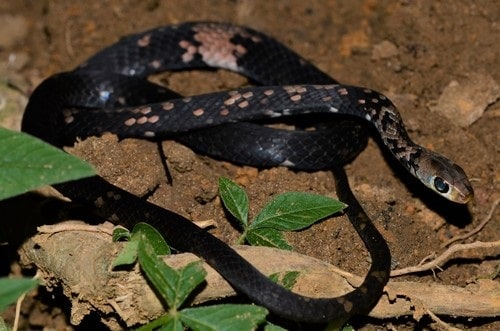
A rainforest snake, also found in clearings next to rainforests, with immensely variable patterns. This is a green-black snake measuring 40-80cm, with neon blue cracks between its scales, which enlarge as they inflate their throats in anger. Philothamnus carinatus cover most of the Congo rainforest region: DRC, Congo, Gabon, and just reach far western Uganda. They also have an island population on Bioko in Equatorial Guinea.
This Congo snake undergoes a great shift with age. As juveniles, they’re a dull brown, and spend their time rummaging around in leaf litter on the rainforest floor. Into adulthood, both their colour and lifestyle transform; they become green with many blue and black shades, and ascend to the high tree branches.
Supposedly, Philothamnus carinatus varies wildly in abundance. In one forest, they’re the most common snake, and in the next forest, they’re nowhere to be found. Their diet is a mystery, and likely contains frogs, similarly to other Philothamnus members. Their confirmed predators include the bird snake (Thelorotnis kirtlandii), a fellow tree branch snake, which is found lower on this list.
| 2 | African bush viper |
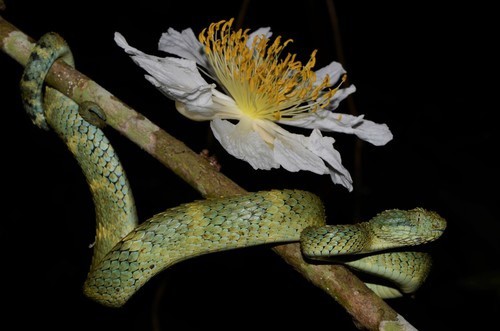
A venomous viper which primarily clings to tree branches, and moves only by night, with the savagely vertical pupils to prove it. Atheris squamigera stretches from Cameroon in the west, through the Congo rainforest, to southwest Kenya in the far east. This is a highly likely snake to stare at you menacingly from a jungled rivershore, while your boat sails uneasily down the Congo river.
Atheris squamigera is a fairly short, though thick snake. In a 2000 study, the maximum male length recorded was 67.0cm, and the maximum female length 70.5cm, while their all-time record of 79.9cm. Most of their diet consisted of mammals, particularly shrews in juveniles, and rodents in adults. African bush vipers regularly remain on the same branch for 48 hours, and they mainly appear in lowland rainforests at altitudes of 100-400m. Atheris squamigera loves forests with the densest, most tangled vegetation, amid rainfall totals of up to 10,000mm annually.
This snake has immense colour variety, from standard green to orange to turquoise. It’s possible that these morphs correlate to certain areas of rainforest, or that they’re totally random.
While not to be underestimated, bites by Atheris squamigera are rarely fatal. A 26 year old man was bitten twice on the foot by his pet in a 2022 report. He suffered minor sensitivity and swelling, and a reduced fibrinogen count of 121, below the healthy range of 180-500 mg/dL. But there’s also reports of a Central African Republic victim who died within 6 days, despite blood transfusions and antivenom infusions. This is a branch-clinging snake, but may block vehicles on roads occasionally.
| 3 | Western forest centipede eater |
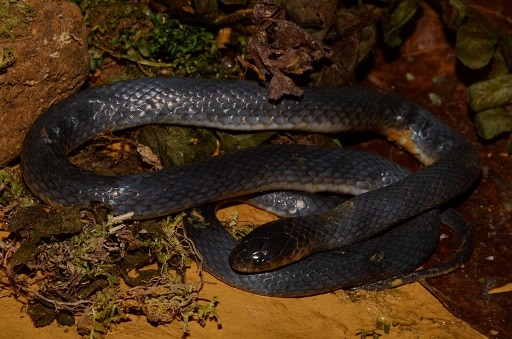
A very indistinct snake, which is black and shiny like many of its neighbours, sometimes with a pale neck collar. The western forest centipede eater (Aparallactus modestus) reaches a maximum of 64.5cm, but is typically 35cm. Forest floors are their domain, in dense primary and secondary rainforest, and they range from Uganda through Congo and DRC to Equatorial Guinea.
Western forest centipede eaters rarely appear near human habitation, but they do appear in thick plantations on the edges of forests. Only a few details are available for this species. A 1966 report mentioned a juvenile Aparallactus modestus coughing up 100 termites. This species is hiding behind a false name, as while the 11-member Aparallactus family does hunt centipedes as a whole, this is a rare species to eat earthworms instead. It possibly wants the local earthworms to know this false name and get complacent.
The difference is evident in its fangs. Other Aparallactus members have a rear fanged venom, designed to subdue dangerous centipedes. But Aparallactus modestus lacks the grooves in its rear fangs which the venom flows down. It’s therefore assumed to have a less developed venom system, as its prey is far less dangerous.
| 4 | Banded water cobra |
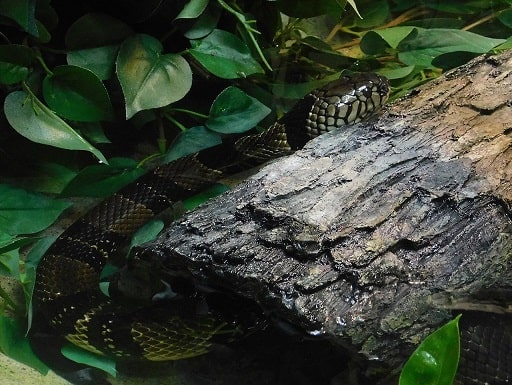
The cobra in Africa most restricted to rainforests. This is so different to other African cobras that along with Christi’s water cobra, it was once placed in the separate genus of Boulengerina. This species inhabits rivers within rainforests, as well as the vegetated shorelines. Banded water cobras (Naja annulata) have a heavily neurotoxic venom, and aquatic adaptions such as a thinner neck hood, reducing underwater drag. They can dive to depths of 25 metres, and easily remain submerged for 20 minutes per session.
Banded water cobras tend to flee rapidly if confronted by humans, escaping to the water where it feels comfortable. They lay 22-24 eggs, and fish dominate their diet. Banded water cobras cause relatively few bites, yet are still capable of dealing out death. A 2022 newspaper report detailed a fisherman in Nyanga, the southernmost province of Gabon. A mystery snake became entangled in his fishing net and sank its fangs into his thumb. The man attempted to kill his serpent assailant with a stone, but died a few minutes later, after mentioning feeling very cold. Scientists reading the newspaper identified it as a banded water cobra, based on patterns in a still image.
Banded waters cobras average at 1.8 metres and occasionally push to 2.8m. Naja annulata is not to be confused with Naja annulifera, the snouted cobra.
| 5 | Ornate African water snake |
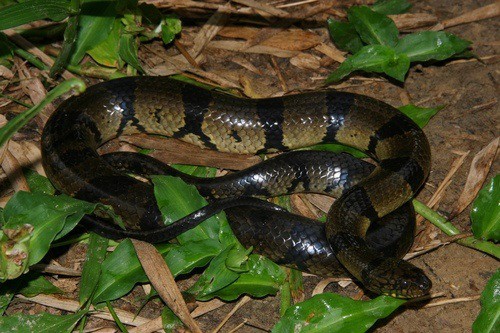
A semi-aquatic snake which feeds overwhelmingly on fish, and occasionally amphibians. Ornate African watersnakes (Grayia ornata) are everywhere in the Congo region, ranging from western Uganda to Equatorial Guinea. Its habitat is essentially rivers and streams through thick forests, similarly to the banded water cobra. Its patterns are also similar: a slimy olive base contrasting vividly with thick black stripes. It’s possible that Grayia ornata is mimicking its deadly neighbour to gain a protective shield.
This species likes to hide in holes in muddy river banks, and has local names such as dibomina and moléngué. Grayia ornata is especially common in Likouala region in northern Congo. They’re so common that fishermen often scoop them up in their nets by mistake. Supposedly, otters love the taste of Grayia smithii, and will try to rip apart nets to acquire them.
Grayia ornata has a particularly long scroll of local folklore in Gabon and beyond. The locals eat this snake, believing it to taste best in dry season when it becomes fattest. Its medicinal powers apparently include improving delivery for birthing women, improving fishing and swimming abilities, treating sprains and aiding newborn babies.
Despite being heavily aquatic, Ornate African watersnakes are also spotted hanging from branches directly above streams. They reach 2-3 metres high, and plummet instantly into the water when spooked. This makes them something of a parallel to the brown watersnake of the USA.
| 6 | Mocquard’s African ground snake |
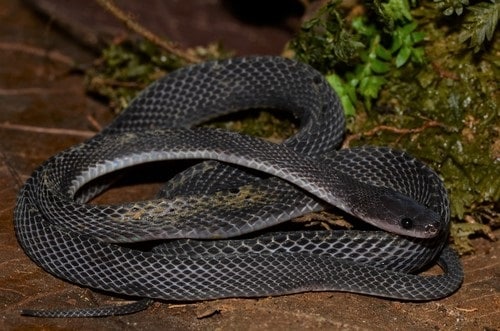
Part of the small Gonionotophis genus, which contains just 3 snakes, all humble forest floor dwellers. If Mocquard’s African ground snake had its way, it would never emerge from its cosy forest confines. It spends most of the day comfortably ensconced in leaf litter or a hollow log, which it identified as the ultimate spot to rest in. This is a snake of primary forest or dense secondary forest. Thick vegetation on the forest floor is ideal for Gonionotophis brussauxi; hence its love for the Congo region.
This snake has a maximum length of 45cm, and an average of 30-40cm. Its scales are black, while the white visible above is actually the interstitial skin between the scales. Their diet is poorly researched, but thought to mainly consist of ground-dwelling frogs. Gonionotophis brussauxi is found in Gabon, DRC, Congo, Central African Republic, and reaches Uganda to the extreme east.
Mocquard’s African ground snakes are nocturnal, moving only under pitch black darkness. Combined with their dark colours, and the thick jungle squeezing out any faint traces of light, this snake is incredibly difficult to spot.
| 7 | Marsh snake |
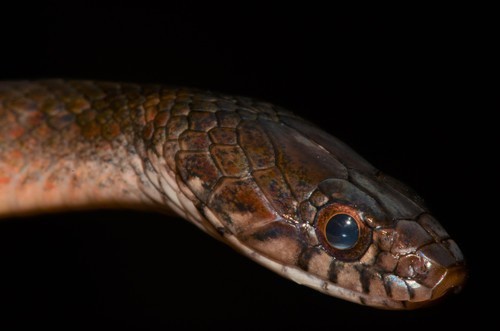
A harmless snake which evolved and lives in rainforests, usually close to rivers, streams and marshes. The marsh snake (Natriciteres fuliginoides) averages at just 20-30cm. It’s rare to find this snake far from water, and their diet consists of amphibians such as golden puddle frogs (Phrynobatrachus auritus).
Forest swamps are one of the best places to find Natriciteres fuliginoides. This snake is found in many countries – Gabon, Congo, DRC, Equatorial Guinea, but are rarely sighted because of their love for deep forests.
The marsh snake is excellent at thermoregulation – it’s able to maintain a consistent and optimal body temperature with very little effort. In many areas of the Congo rainforest, they coexist with their cousin, the variable marsh snake (Natriciteres variegata). A 2002 study tested whether their presence inspires heavy competition between them. It found when the two coexisted, marsh snakes were more likely to 1) eat prey from land, 2) switch to focussing on smaller prey, and 3) shift towards invertebrate prey, and away from vertebrates. It’s possible that N. variegata is a stronger hunter than this one, forcing it into niches it is less adapted to.
| 8 | Laurent’s tree snake |
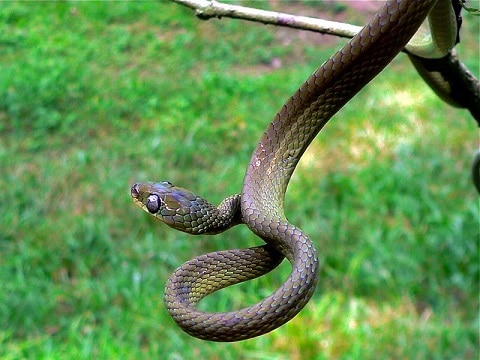
Dipsadoboa is a snake genus with 12 members, which aren’t necessarily rainforest-dwelling, but Laurent’s tree snake (Dipsadoboa viridis) certainly is. This species is often found on branches directly overhanging small streams within rainforests. When confronted, they kink their body into a strange shape, designed to mimic vines and foliage. If found on the forest floor, they’ll coil into a tight ball in order to hide their head. Luckily, hundreds of thousands of this species will never even meet a human, as they regularly live in the deepest regions of the Congo, such as Gabon’s Mwagna National Park.
Laurent’s tree snakes mainly feed on reptiles and amphibians, including ridged frogs (Ptychadena). They take this down using a rear-fanged venom whose effects on humans remain unknown. Rainforest swamps are another great place to find them. Lowland rainforests are their favourites and they also appear in cacao and banana plantations adjacent to rainforests, as their bushiness is sufficient for them.
Laurent’s tree snake is an egg-laying species, pumping out batches of 3-5. They average at 70-100cm, with a record of 124cm. One of their relatives is the marbled snake of Mozambique (D. aulica), which appears more commonly in savannah.
| 9 | Bird snake |
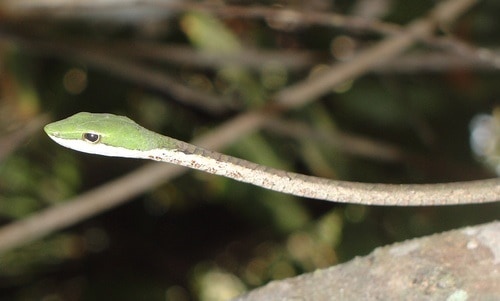
One of the most abundant snakes in the Congo rainforest region. The bird snake (Thelotornis kirtlandii) is also one of the Congo rainforest’s longest snakes, at up to 1.8 metres. At birth, they measure 25-30cm.
This is a tree-dwelling snake, with the signature ability to expand their throat to bizarre levels, like a pelican about to swallow. Its venom targets blood coagulation, disrupting clotting elements and causing uncontrollable bleeding. There’s no antivenom, and one death is confirmed in an 80 year old woman, who died from kidney failure.
Bird snakes don’t instantly fly into a panic when humans approach. They often keep their cool, ignoring the intruders into their forest domain. Should you touch them, however, they’ll instantly erupt into a vicious assault.
Bird snakes lay particularly long, thin eggs, and they occasionally lay these eggs in ants’ nests. Popular prey for this snake include Ploceus weaverbirds. As well as thirteen-scaled green snakes, they’re confirmed predators of emerald snakes. A 1998 study examined a swamp in southeast Nigeria and recorded the banded-leaf toed gecko seven times as prey, as well as a rufous-winged cisticola. Reptiles and occasionally birds seems to be their menu.
| 10 | Blackbelly snake |
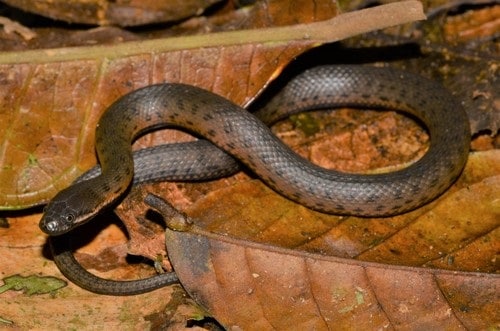
A moderately sized rainforest snake which peaks at 90cm. The blackbelly snake (Hydraethiops melanogaster) inhabits the western portions of Central Africa: Congo, Gabon, Equatorial Guinea, and Central African Republic.
This is a semi-aquatic snake, which preys mainly on fish. Rainforests are its domain; you’ll never find the blackbelly snake in a small rain pool in a dry savannah. Up close, this snake has fairly complex patters. There’s a creamy stripe beginning from its eye, ending after the neck. Its body is a murky brown, but overlaid with dozens of black, diamond-shaped markings. Because these are so small, they fade away at a distance. Its head is fairly distinct from its neck (though not triangular like a viper’s), and its eyes are fairly small, with round pupils rather than vertical.
This is believed to be a non-venomous snake, though several non-venomous snakes have turned out to secrete a mild rear-fanged venom. The Hydraethiops genus has just two members, the other being the even rarer Hydraethiops laevis, also found in the Congo rainforest.
